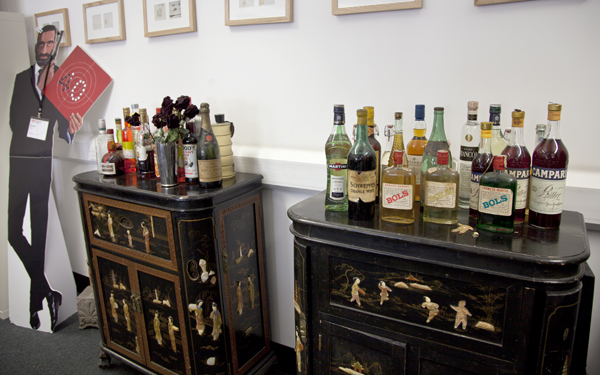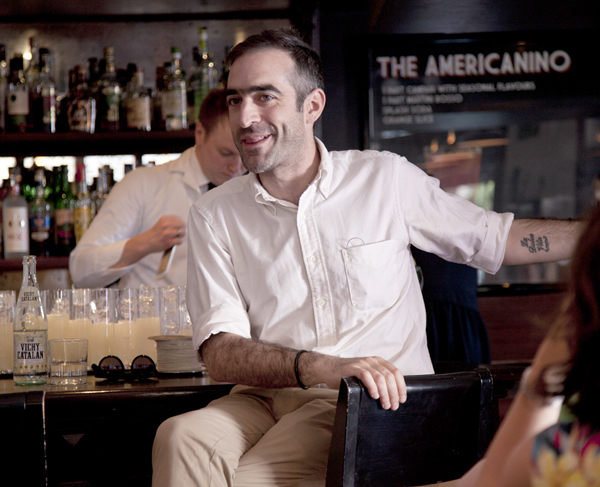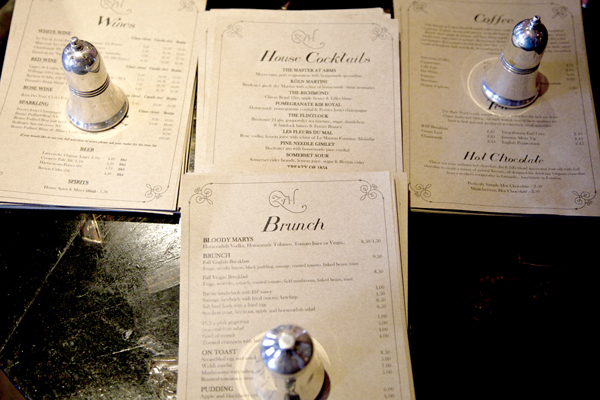“What is a cocktail?” “Cock-tail is a stimulating liquor, composed of spirits of any kind, sugar, water, and bitters—it is vulgarly called bittered sling, and is supposed to be an excellent electioneering potion, inasmuch as it renders the heart stout and bold, at the same time that it fuddles the head. It is said, also to be of great use to a democratic candidate: because a person, having swallowed a glass of it, is ready to swallow any thing else.”
[First ever mention of ‘cocktail’ – The Balance and Columbian Repository publication, Hudson, New York, May13, 1806]
How does one take one’s cocktail? Well, the imbibition stage is rather easy, but to start with, one usually has to get someone else to make it for you. It is the ultimate end of slog ‘pat on back’. A cold beer, as we all know, refreshes most parts, but a cocktail says, “Yes, you are worth it, even if your boss doesn’t realize it yet”. Originally a mixture of spirits, sugar, water and bitters, a cocktail today can contain any number of ingredients. So may we sit contentedly toying a maraschino cherry around an old fashioned, I ask you? Heck no, certainly not us Londoners. As with any busy metropolis, you find a constant hunger of wanting more, wanting different, a relentless drive for new and ingenious ways of presenting and viewing things. And what with the growing fascination of molecular gastronomy with chefs across the world, it wasn’t going to be too long before the cocktail world would follow suit. What started off with the lyrical layering of the 90’s favorite Friday night tipple, the B52, has now spawned an industry of cocktail wizards. And steering the rudder through these heady waters is London’s very own mixologist maestro, Tony Conigliaro.
 Tony Conigliaro knows his drinks, having shaken, muddled, stirred, built, layered, floated and rolled his way up the ranks of London’s top bars, from the likes of Isola, The Lonsdale, and the Shochu lounge at Roka. He is a self-taught pioneer who was not satisfied with merely doing a good days work. Tony paid close attention to the work of the chefs that surrounded him and slowly began to infuse their tricks into his own repertoire. For anyone who has eaten the food of a molecular gastronomist, you will know that the results are groundbreaking, mindboggling, thought provoking and jaw dropping. And through the investigation to the responsiveness of basic ingredients and experimentation with their density and viscosity comes a wish for greater intensities, varieties of seasoning, taste combinations and approach to presentation. Equipment ranges from blowtorches, vacuum sealers (used to combine, preserve and infuse ingredients, including non-edible matter such as tobacco, leather and perfume) the rotavap (a vacuum rotary distillation setup that allows the extraction of aromas, low temperature reduction of juices and the production of flavored spirits) and such techniques like spherification. (forming a liquid into a sphere, much like caviar or larger like an egg yolk) The input is science, but the outcome is pure poetry. Tony opened his trailblazing Islington ‘Bar with no name’ at 69 Colebrooke Row four years ago, blindsiding all the critics and scooping all of the top honors in one swift swoop. The subtle decor is a gentle nudge to 1950’s Italian film noir. In May 2012, the Sunday Times unabashedly voted it the best bar on earth. Favorable libations include the reinvented Prairie Oyster, (tomato yolk, horseradish vodka, Oloroso Sherry, shallots, pepper sauce, celery salt and micro herbs) Terroir (distilled clay, flint and lichen), Apple and Hay Bellini, (yes, you heard correct) the Smoked Old Fashioned (using essence of tobacco, smoke essence and leather essence) and the No.5 Champagne Cocktail, of which came about at the realization that the process of constructing cocktails is very much parallel to that of perfumery, – both of which revolve around the use of top, mid and base notes with the dissolving sugar cube at the bottom of the champagne flute able to bring the notes of the drink to the top. The concept behind the Smoked Old Fashioned was “to put the idea of the drink inside the drink i.e. to sit down in a big leather sofa with a cigar and smoke-swirling drink”. It is this reason why many bartenders across the globe consider Tony as THE go-to drinks authority. Such was the demand that Tony set up his lab the Drink Factory in Britannia Row as a collective space for learning and sharing knowledge in the craft of cocktails. Interested parties include chefs, chocolatiers, perfumers, designers as well as drinks experts.
Tony Conigliaro knows his drinks, having shaken, muddled, stirred, built, layered, floated and rolled his way up the ranks of London’s top bars, from the likes of Isola, The Lonsdale, and the Shochu lounge at Roka. He is a self-taught pioneer who was not satisfied with merely doing a good days work. Tony paid close attention to the work of the chefs that surrounded him and slowly began to infuse their tricks into his own repertoire. For anyone who has eaten the food of a molecular gastronomist, you will know that the results are groundbreaking, mindboggling, thought provoking and jaw dropping. And through the investigation to the responsiveness of basic ingredients and experimentation with their density and viscosity comes a wish for greater intensities, varieties of seasoning, taste combinations and approach to presentation. Equipment ranges from blowtorches, vacuum sealers (used to combine, preserve and infuse ingredients, including non-edible matter such as tobacco, leather and perfume) the rotavap (a vacuum rotary distillation setup that allows the extraction of aromas, low temperature reduction of juices and the production of flavored spirits) and such techniques like spherification. (forming a liquid into a sphere, much like caviar or larger like an egg yolk) The input is science, but the outcome is pure poetry. Tony opened his trailblazing Islington ‘Bar with no name’ at 69 Colebrooke Row four years ago, blindsiding all the critics and scooping all of the top honors in one swift swoop. The subtle decor is a gentle nudge to 1950’s Italian film noir. In May 2012, the Sunday Times unabashedly voted it the best bar on earth. Favorable libations include the reinvented Prairie Oyster, (tomato yolk, horseradish vodka, Oloroso Sherry, shallots, pepper sauce, celery salt and micro herbs) Terroir (distilled clay, flint and lichen), Apple and Hay Bellini, (yes, you heard correct) the Smoked Old Fashioned (using essence of tobacco, smoke essence and leather essence) and the No.5 Champagne Cocktail, of which came about at the realization that the process of constructing cocktails is very much parallel to that of perfumery, – both of which revolve around the use of top, mid and base notes with the dissolving sugar cube at the bottom of the champagne flute able to bring the notes of the drink to the top. The concept behind the Smoked Old Fashioned was “to put the idea of the drink inside the drink i.e. to sit down in a big leather sofa with a cigar and smoke-swirling drink”. It is this reason why many bartenders across the globe consider Tony as THE go-to drinks authority. Such was the demand that Tony set up his lab the Drink Factory in Britannia Row as a collective space for learning and sharing knowledge in the craft of cocktails. Interested parties include chefs, chocolatiers, perfumers, designers as well as drinks experts.
[69 Colebrooke Row]
 Tony’s next venture was to team up with his Isola colleague and friend, the chef Bruno Loubet along with the Zetter Hotel group (Mark Sainsbury and Michael Benyan) in transforming 2 Georgian townhouses in Clerkenwell, which was to become known as the Zetter Townhouse. The approach was totally different in the fact that the place pivots entirely around the made up figure of ‘aunt Wilhelmina’, – “a composite of all dotty aunts”. For every detail and nuance it was “what would aunt Wilhelmina want” and so historical imagination and playful narrative has helped create an immersive experience that will hopefully fire up ones imagination, – a progressive trend that is currently proving very popular in London. Lovingly decorated by the brilliant interior designer, Russell Sage, the result is a riotous mish-mash of oddities, colours, fabrics, textures and exuberant taxidermy. It is organized chaos at its finest form. Nevertheless, it’s homey, snug and inviting to the point where you have to keep reminding yourself to not even think about putting your feet up on the coffee table. The foundations of this 13-bedroom townhouse were built around the 7th Century Priory walls and the food and drink menu gently doffs its cap in homage to both the area’s priory and Dickensian roots. Knowing when to pull back, Tony said he was careful not to overplay the drinks here, basing them largely on 17th/18th Century recipes, remedies, tinctures and infusions. You can eat Scotch egg or Beef daube Bourgignon and wash it down with a Flintlock, (Beefeater 24 gin, gunpowder tea tincture, sugar, dandelion, burdock bitters & Fernet Branca) Somerset Sour, (Somerset cider brandy, lemon juice, sugar and Breton cider) or Milk Collins. (Beefeater gin, homemade milk syrup, lemon juice, sugar & soda) The filtered water is even sourced from the very Fleet River beneath ones feet. This is a complete turnabout from 69 Colebrooke Row, in which here it’s the surrounding that does most of the hollering. A man of many appreciations it’s obvious that Tony is sympathetic to subtleties and understands the art of balance, not just in liquid form. Tony, Bruno and the Zetter team have recently trounced again this year, opening up the Grain Store in the newly developed area north of Kings Cross, an energized vegetable and fruit-dominant menu that proves that they are certainly no one-trick ponies.
Tony’s next venture was to team up with his Isola colleague and friend, the chef Bruno Loubet along with the Zetter Hotel group (Mark Sainsbury and Michael Benyan) in transforming 2 Georgian townhouses in Clerkenwell, which was to become known as the Zetter Townhouse. The approach was totally different in the fact that the place pivots entirely around the made up figure of ‘aunt Wilhelmina’, – “a composite of all dotty aunts”. For every detail and nuance it was “what would aunt Wilhelmina want” and so historical imagination and playful narrative has helped create an immersive experience that will hopefully fire up ones imagination, – a progressive trend that is currently proving very popular in London. Lovingly decorated by the brilliant interior designer, Russell Sage, the result is a riotous mish-mash of oddities, colours, fabrics, textures and exuberant taxidermy. It is organized chaos at its finest form. Nevertheless, it’s homey, snug and inviting to the point where you have to keep reminding yourself to not even think about putting your feet up on the coffee table. The foundations of this 13-bedroom townhouse were built around the 7th Century Priory walls and the food and drink menu gently doffs its cap in homage to both the area’s priory and Dickensian roots. Knowing when to pull back, Tony said he was careful not to overplay the drinks here, basing them largely on 17th/18th Century recipes, remedies, tinctures and infusions. You can eat Scotch egg or Beef daube Bourgignon and wash it down with a Flintlock, (Beefeater 24 gin, gunpowder tea tincture, sugar, dandelion, burdock bitters & Fernet Branca) Somerset Sour, (Somerset cider brandy, lemon juice, sugar and Breton cider) or Milk Collins. (Beefeater gin, homemade milk syrup, lemon juice, sugar & soda) The filtered water is even sourced from the very Fleet River beneath ones feet. This is a complete turnabout from 69 Colebrooke Row, in which here it’s the surrounding that does most of the hollering. A man of many appreciations it’s obvious that Tony is sympathetic to subtleties and understands the art of balance, not just in liquid form. Tony, Bruno and the Zetter team have recently trounced again this year, opening up the Grain Store in the newly developed area north of Kings Cross, an energized vegetable and fruit-dominant menu that proves that they are certainly no one-trick ponies.
Nicholas Kurti, the late Oxford physicist first coined the term ‘molecular gastronomy’ in 1992. He once mused that, “I think it is a sad reflection on our civilization that while we can and do measure the temperature in the atmosphere of Venus, we do not know what goes on inside our soufflés.” I can hear many balk at the idea of messing around with food as simply unnecessary and to a degree, simply showing off. However, we are now dawning on a regrettable age where there are no more surprises. We landed man on the moon, he wandered and pondered around for a bit, realized his limitations and imperfections…and he has returned home. It is now time to reflect and look inwardly. I feel people have to remember that there are miracles to be found close at hand, – you don’t have to reach for the skies to find the stars. We look outward to the big things and forget the importance of looking in and noticing the finer details, understanding the balance in the elements. I applaud the genius of the likes of Tony Conigliaro, simply for the fact that he constantly pushes the boundaries, he dares to be extraordinary and refined no matter how far-fetched or simplistic the idea. Tony sums it up, saying “the more practiced you are, the more you become adept at making beautiful and simple things”. I finish off by asking Tony for his thoughts on the perfect Martini…”definitely stirred and not shaken”, he offers resolutely. Sorry, Mr. Bond. This time you were wrong.
________________________________
This story was made possible by The School of Life, who regularly operate talks and classes with Tony Conigliaro
Alternatively, you can contact 69 Colebrooke Row for their masterclasses directly.


















































Great post – couple of extra insights – I was recently in New Orleans where I was informed that Peychaud (bitters maker) father the name cocktail as it derived from the fact that he served drinks in an egg cup (called a “coquetier” in French) from which the name derived. As to ‘shaken not stirred’ if I may refer you to my post on Duke’s it may shed some light on this – shaken was never meant to be the right way to do… but the anti-establishment way. http://londonunveiled.com/2013/01/17/dukes-bar/
Very interesting. There are a couple of theories, – “Cock” was another name for spigot, and “tailings” is the last bit of alcohol, so this drink was called “cock-tailings,” A similar theory claims that leftover liquors from drinks served were dumped into a ceramic container shaped like a rooster, and you could get cheap drinks from a tap set in the tail of the rooster; hence these drinks were called “cock’s tail.”